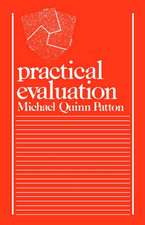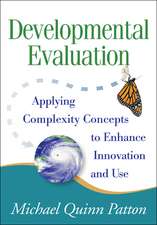Getting to Maybe: How the World Is Changed
Autor Frances Westley, Brenda Zimmerman, Michael Quinn Pattonen Limba Engleză Paperback – 31 iul 2007
Many of us have a deep desire to make the world around us a better place. But often our good intentions are undermined by the fear that we are so insignificant in the big scheme of things that nothing we can do will actually help feed the world’s hungry, fix the damage of a Hurricane Katrina or even get a healthy lunch program up and running in the local school. We tend to think that great social change is the province of heroes – an intimidating view of reality that keeps ordinary people on the couch. But extraordinary leaders such as Gandhi and even unlikely social activists such as Bob Geldof most often see themselves as harnessing the forces around them, rather than singlehandedly setting those forces in motion. The trick in any great social project – from the global fight against AIDS to working to eradicate poverty in a single Canadian city – is to stop looking at the discrete elements and start trying to understand the complex relationships between them. By studying fascinating real-life examples of social change through this systems-and-relationships lens, the authors of Getting to Maybe tease out the rules of engagement between volunteers, leaders, organizations and circumstance – between individuals and what Shakespeare called “the tide in the affairs of men.”
Getting to Maybe applies the insights of complexity theory and harvests the experiences of a wide range of people and organizations – including the ministers behind the Boston Miracle (and its aftermath); the Grameen Bank, in which one man’s dream of micro-credit sparked a financial revolution for the world’s poor; the efforts of a Canadian clothing designer to help transform the lives of aboriginal women and children; and many more – to lay out a brand new way of thinking about making change in communities, in business, and in the world.
From the Hardcover edition.
Preț: 102.30 lei
Nou
Puncte Express: 153
Preț estimativ în valută:
19.57€ • 20.44$ • 16.20£
19.57€ • 20.44$ • 16.20£
Carte disponibilă
Livrare economică 14-28 martie
Livrare express 27 februarie-05 martie pentru 28.69 lei
Preluare comenzi: 021 569.72.76
Specificații
ISBN-13: 9780679314448
ISBN-10: 067931444X
Pagini: 258
Dimensiuni: 175 x 229 x 20 mm
Greutate: 0.45 kg
Editura: Vintage Books Canada
ISBN-10: 067931444X
Pagini: 258
Dimensiuni: 175 x 229 x 20 mm
Greutate: 0.45 kg
Editura: Vintage Books Canada
Notă biografică
Frances Westley has published widely in the areas of strategic change and visionary leadership, and led the Dupont Canada—fostered think-tank on social innovation, based at McGill University’s Desautel Faculty of Management, where many of the ideas for this book were developed.
Brenda Zimmerman, a professor at the Schulich School of Business at York University, has been studying and writing about how complexity theory applies to organizations for twenty years.
Michael Quinn Patton is an independent organizational development consultant and has written five major books on the art and science of program evaluation.
From the Hardcover edition.
Brenda Zimmerman, a professor at the Schulich School of Business at York University, has been studying and writing about how complexity theory applies to organizations for twenty years.
Michael Quinn Patton is an independent organizational development consultant and has written five major books on the art and science of program evaluation.
From the Hardcover edition.
Extras
Our deepest fear is not that we are inadequate. Our deepest fear is that we are powerful beyond measure. It is our light, not our darkness that most frightens us. We ask ourselves, who am I to be brilliant, gorgeous, talented fabulous? Actually, who are you not to be? . . . Your playing small does not serve the world. There’s nothing enlightened about shrinking so that other people won’t feel insecure around you. We are all meant to shine, as children do. . . . It is not just in some of us; it is in everyone. And as we let our own light shine, we unconsciously give other people permission to do the same. As we are liberated from our own fear, our presence automatically liberates others.
–Marianne Williamson, A Return to Love
1. The First Light of Evening
From 1984 to the autumn of 1985, Bob Geldof, the lead singer of Irish rock band the Boomtown Rats, raised over sixty million pounds for famine relief in Ethiopia. He did it by organizing Band Aid, first cutting a best-selling song in collaboration with British rock stars and then organizing a huge Live Aid telethon, which lasted seventeen hours and was broadcast from both sides of the Atlantic. Geldof was seized with the determination to help the starving of Ethiopia while watching a BBC documentary on the famine. Hundreds of people were involved in making Live Aid successful, but the vision behind the effort was his. Live Aid not only set a standard for international rock concerts, but also tapped a new charitable niche – youth – and challenged the aid delivery system set up by governments and non-governmental organizations (NGOs). Geldof worked out a strategy that allowed him to use the expertise and distribution systems of existing aid organizations while he cut through much of the red tape that traditionally slowed aid delivery.
While Live Aid did not solve the problem of famine in Africa, Geldof was widely praised for his innovative contribution. He has been knighted, won numerous awards, and was nominated in 1986 for the Nobel Peace Prize. And yet, in many ways he was an unlikely hero. By his own admission, he was a marginally successful musician who had been leading a desolate life and making little effort to contribute to anything other than his musical career. He had been born poor and never received much of an education. As one journalist wrote, “God opened the door and saw this scruffy Irishman and said, ‘Oh what the heck, he’ll do.’”
And he did.
–
In 1997, the World Bank reported that an estimated thirty million people had contracted HIV/AIDS and 90 percent of them were in developing countries. Statistics from the UN show this number had climbed to forty million by 2004 and is predicted to climb by another twenty million in the next two decades. Among those countries hardest hit is South Africa, which has the highest number of infected people of any country.
By any number of measures, Brazil should be at the top of the list with South Africa. In 1990, Brazil had almost twice as many cases of HIV/AIDS as South Africa, and a World Bank study predicted that Brazil would have off-the-chart infection rates for HIV/AIDS by the turn of the millennium. The World Bank researchers told Brazil to focus on prevention – and in effect to be prepared to lose all those infected before the epidemic was under control.
At the start of the new millennium, as predicted, one in four people in South Africa were infected with HIV. However, in Brazil, a miracle occurred: the country’s infection rate had dropped to 0.6 percent (1 in 160). Today, Brazil is touted as a model for developing countries fighting HIV/AIDS. How did this miracle happen?
If you look for a charismatic leader who inspired the people, you quickly realize there wasn’t one. Instead, Brazilians at all levels, from government bureaucrats to local community leaders, joined forces in the service of a key guiding principle: no person, no matter how poor, insignificant or illiterate, could be written off as beyond cure. Liberation theology, a version of Catholicism that infuses Brazilian culture, proclaims the importance of empowering the poor and creating liberty for all. Health care workers looked for ways to ensure treatment would be available to all citizens regardless of their ability to pay and found resources that were hidden from external observers and HIV/AIDS experts. Volunteers from churches and other non-health charities worked alongside the clinical experts, and became invaluable in both helping people follow complicated drug regimens and learning ways to prevent infection. At the government level, a clause in an international trade agreement was used to wage a successful legal battle for the right to make generic drugs in cases of national emergency, which reduced the price of HIV/AIDS drugs.
To spread the prevention message, the Brazilians decided to use humour rather than fear. Clowns wearing costumes made of condoms handed out condom lollipops to drive home the safesex message in a fun and memorable way. One playful billboard depicted three beautiful women sitting around a condom-shaped table. The thought bubbles above their heads all said “Si.” The message was that women will say yes, yes, yes to men who use condoms! These campaigns were in stark contrast to those in most other countries, which stressed “Use condoms or you could die.” Clearly Brazilians did not want anyone to die of AIDS. But they reasoned that youth, who were the most susceptible to contracting HIV, often feel invulnerable and rarely are thinking about death, especially when they are contemplating sex.
–
Live Aid is a miracle in close-up, which in our awestruck or inadequate moments we can put down to the actions of a hero – an individual larger than ourselves who is capable of changing the course of history. How, we wonder, could Bob Geldof have done this by himself? What was happening around him and to him that made such action possible? In his own words, “Doors impenetrable a week earlier swung open effortlessly.” Many of our good intentions seem to be smothered before we get off the couch. How were his efforts magnified and amplified?
From the Hardcover edition.
–Marianne Williamson, A Return to Love
1. The First Light of Evening
From 1984 to the autumn of 1985, Bob Geldof, the lead singer of Irish rock band the Boomtown Rats, raised over sixty million pounds for famine relief in Ethiopia. He did it by organizing Band Aid, first cutting a best-selling song in collaboration with British rock stars and then organizing a huge Live Aid telethon, which lasted seventeen hours and was broadcast from both sides of the Atlantic. Geldof was seized with the determination to help the starving of Ethiopia while watching a BBC documentary on the famine. Hundreds of people were involved in making Live Aid successful, but the vision behind the effort was his. Live Aid not only set a standard for international rock concerts, but also tapped a new charitable niche – youth – and challenged the aid delivery system set up by governments and non-governmental organizations (NGOs). Geldof worked out a strategy that allowed him to use the expertise and distribution systems of existing aid organizations while he cut through much of the red tape that traditionally slowed aid delivery.
While Live Aid did not solve the problem of famine in Africa, Geldof was widely praised for his innovative contribution. He has been knighted, won numerous awards, and was nominated in 1986 for the Nobel Peace Prize. And yet, in many ways he was an unlikely hero. By his own admission, he was a marginally successful musician who had been leading a desolate life and making little effort to contribute to anything other than his musical career. He had been born poor and never received much of an education. As one journalist wrote, “God opened the door and saw this scruffy Irishman and said, ‘Oh what the heck, he’ll do.’”
And he did.
–
In 1997, the World Bank reported that an estimated thirty million people had contracted HIV/AIDS and 90 percent of them were in developing countries. Statistics from the UN show this number had climbed to forty million by 2004 and is predicted to climb by another twenty million in the next two decades. Among those countries hardest hit is South Africa, which has the highest number of infected people of any country.
By any number of measures, Brazil should be at the top of the list with South Africa. In 1990, Brazil had almost twice as many cases of HIV/AIDS as South Africa, and a World Bank study predicted that Brazil would have off-the-chart infection rates for HIV/AIDS by the turn of the millennium. The World Bank researchers told Brazil to focus on prevention – and in effect to be prepared to lose all those infected before the epidemic was under control.
At the start of the new millennium, as predicted, one in four people in South Africa were infected with HIV. However, in Brazil, a miracle occurred: the country’s infection rate had dropped to 0.6 percent (1 in 160). Today, Brazil is touted as a model for developing countries fighting HIV/AIDS. How did this miracle happen?
If you look for a charismatic leader who inspired the people, you quickly realize there wasn’t one. Instead, Brazilians at all levels, from government bureaucrats to local community leaders, joined forces in the service of a key guiding principle: no person, no matter how poor, insignificant or illiterate, could be written off as beyond cure. Liberation theology, a version of Catholicism that infuses Brazilian culture, proclaims the importance of empowering the poor and creating liberty for all. Health care workers looked for ways to ensure treatment would be available to all citizens regardless of their ability to pay and found resources that were hidden from external observers and HIV/AIDS experts. Volunteers from churches and other non-health charities worked alongside the clinical experts, and became invaluable in both helping people follow complicated drug regimens and learning ways to prevent infection. At the government level, a clause in an international trade agreement was used to wage a successful legal battle for the right to make generic drugs in cases of national emergency, which reduced the price of HIV/AIDS drugs.
To spread the prevention message, the Brazilians decided to use humour rather than fear. Clowns wearing costumes made of condoms handed out condom lollipops to drive home the safesex message in a fun and memorable way. One playful billboard depicted three beautiful women sitting around a condom-shaped table. The thought bubbles above their heads all said “Si.” The message was that women will say yes, yes, yes to men who use condoms! These campaigns were in stark contrast to those in most other countries, which stressed “Use condoms or you could die.” Clearly Brazilians did not want anyone to die of AIDS. But they reasoned that youth, who were the most susceptible to contracting HIV, often feel invulnerable and rarely are thinking about death, especially when they are contemplating sex.
–
Live Aid is a miracle in close-up, which in our awestruck or inadequate moments we can put down to the actions of a hero – an individual larger than ourselves who is capable of changing the course of history. How, we wonder, could Bob Geldof have done this by himself? What was happening around him and to him that made such action possible? In his own words, “Doors impenetrable a week earlier swung open effortlessly.” Many of our good intentions seem to be smothered before we get off the couch. How were his efforts magnified and amplified?
From the Hardcover edition.
Recenzii
“Getting to Maybe addresses making big, significant change actually happen. It is thoughtful, insightful, sobering and inspirational. The ideas articulated are new and practical. Anyone from the business, government or not-for-profit world who wants to understand change better, and change the way things are, should read this book.”
—Courtney Pratt, chairman of Stelco
—Courtney Pratt, chairman of Stelco
















